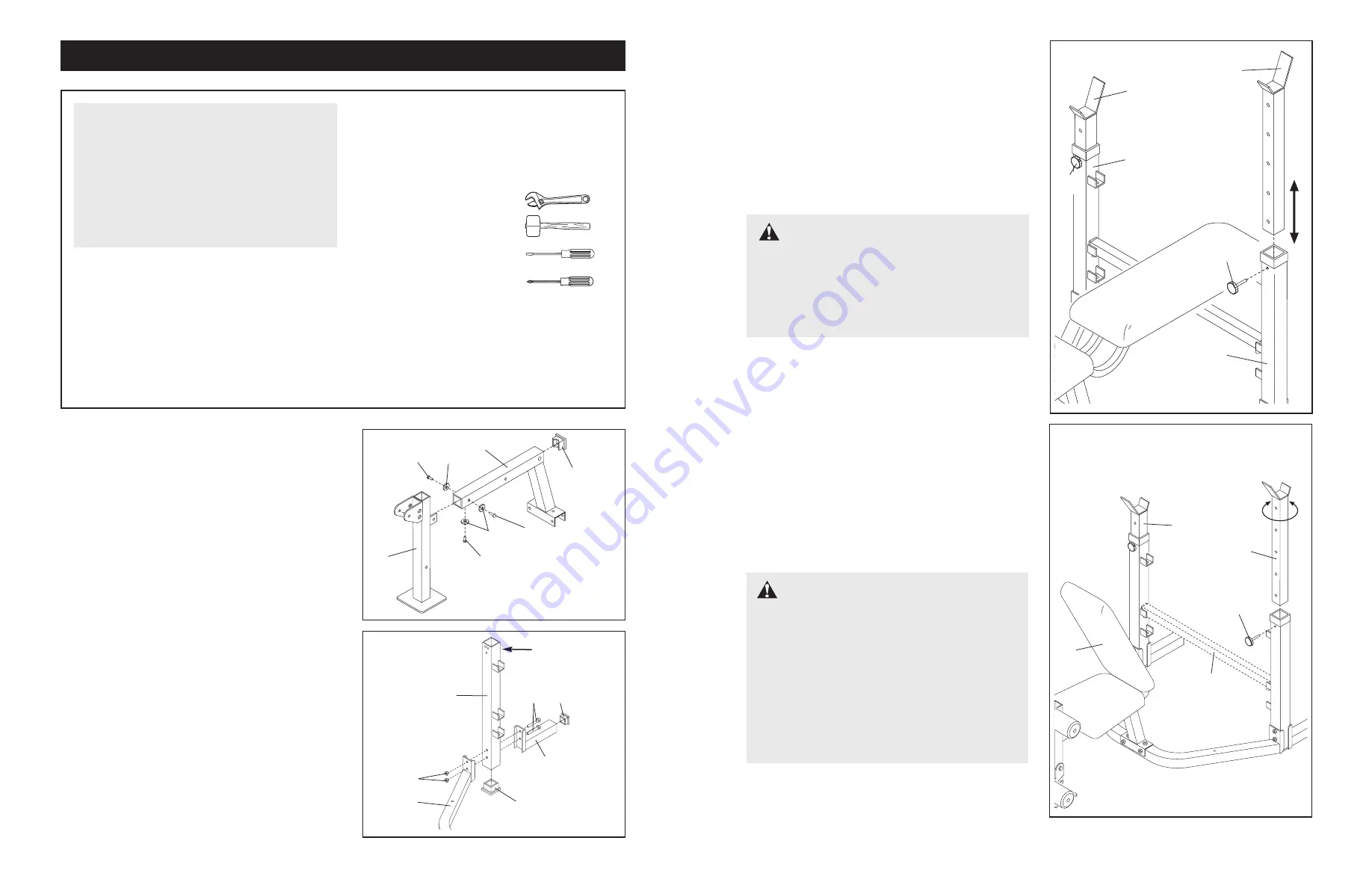
6
11
ADJUSTING THE WEIGHT BENCH FOR SQUAT
EXERCISES
To perform squat or toe raise exercises, fold the
Backrest (23) to the upright position as described on
page 10. Remove the Adjustment Tube (12).
Turn the Weight Rests (11) around, as shown, and
adjust them to the highest setting (see ADJUSTING
THE WEIGHT RESTS, above).
WARNING:
Always place 23 kg (50
lbs.) on the leg lever to balance the bench when
performing squat exercises.
Always fold the Backrest (23) out of the way
when performing squat exercises.
Do not stand with your back to the weight
bench when performing squat exercises. You
should be able to see the weight rests while
exercising so that you can safely return the bar-
bell (not included) when you finish the exercise.
25
12
11
11
23
1.
Before assembling this product, make sure you
have read and understand the information in the
box above.
Insert a 1 3/4” Slotted Square Inner Cap (50) into the
Bench Frame (5).
Attach the Bench Frame (5) to the bracket on the
Front Leg (4) with three M8 x 16mm Bolts (39) and
three M8 Washers (21).
Do not fully tighten the
Bolts.
1
•
Assembly requires two people.
•
As you assemble the weight bench, make sure all
parts are oriented as shown in the drawings.
•
Tighten all parts as you assemble them, unless
instructed to do otherwise.
•
For help identifying small parts, use the Part
Identification Chart on page 5.
•
Place all parts in a cleared area and remove the
packing materials. Do not dispose of the packing
materials until assembly is completed.
The following tools (not included) are required
for assembly:
• Two adjustable spanners
• One rubber mallet
• One standard screwdriver
• One phillips screwdriver
• Lubricant, such as grease or petroleum jelly,
and soapy water.
Assembly will be more convenient if you have the
following tools: A socket set, a set of open-end or
closed-end spanners or a set of ratchet spanners.
Assembly
Make Things Easier for Yourself
Everything in this manual is designed to ensure
that the weight bench can be assembled suc-
cessfully by anyone. However, it is important to
recognise that the weight bench has many
small parts, and that the assembly process will
take time. Most people find that by setting aside
plenty of time, and by deciding to make the task
enjoyable, assembly will go smoothly.
39
5
4
21
39
39
50
21
2.
Identify the Left Upright (8) by the location of the
welded nut.
Press a 2” Square Inner Cap (29) into the lower end
of the Left Upright (8). Press a 45mm Square Inner
Cap (27) into an Upright Stabiliser (28).
Attach the Left Base (6) and the Upright Stabiliser
(28) to the Left Upright (8) with two M8 x 67mm Bolts
(42) and two M8 Nylon Locknuts (40).
Do not tighten
the Nylon Locknuts yet.
Repeat this step with the Right Upright (not
shown) and the Right Base (not shown).
2
28
27
29
8
Welded Nut
6
42
40
ADJUSTING THE WEIGHT RESTS
To change the height of the Weight Rests (11), first
remove your barbell (not shown).
While holding a Weight Rest (11) with one hand,
remove the M10 Adjustment Knob (25) from the Upright
(8 or 9). Move the Weight Rest to the desired position.
Insert the Adjustment Knob through the Upright and the
Weight Rest, and turn it clockwise until it is tight. Adjust
the other Weight Rest in the same manner.
Make sure
that you fully tighten the Adjustment Knobs.
WARNING:
Always set both Weight
Rests (11) at the same height. The M10
Adjustment Knobs (25) must be inserted
through the Uprights (8, 9) and the Weight Rests
(11).
Never tighten the Adjustment Knobs into
the Uprights and then set the Weight Rests in
the Uprights on top of the Adjustment Knobs.
11
8
11
9
25
25























